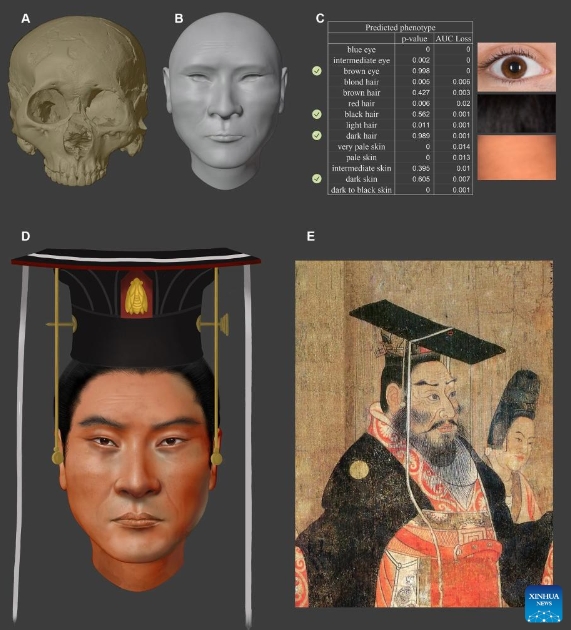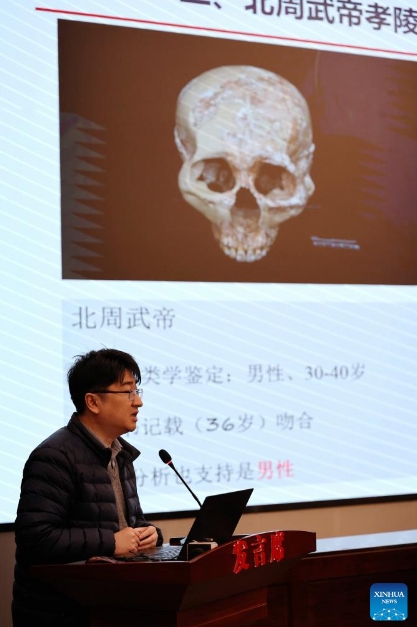Scientists restore profile of ancient Chinese emperor through genetic analysis

This picture published on March 28, 2024 shows the restored image of Yuwen Yong, Emperor Wu of the Xianbei-led Northern Zhou Dynasty (557-581). A team of Chinese scientists have completed the genetic profile of an ancient Chinese ethnic minority emperor via genome analysis, according to local archaeologists on Thursday. (Xinhua/Li Yibo)
A team of Chinese scientists have completed the genetic profile of an ancient Chinese ethnic minority emperor via genome analysis, according to local archaeologists on Thursday.
Emperor Wu of the Xianbei-led Northern Zhou Dynasty (557-581), also known as Yuwen Yong, was an ambitious leader who died at 36. He belonged to the Xianbei nomadic group, which originated from the Mongolian Plateau.
His skull and bones were discovered during an excavation held in 1994 and 1995 at the site of his tomb. By spending six years studying DNA found in his remains, scientists led by Wen Shaoqing from the Institute of Archaeological Science of Fudan University, managed to decode key features of the emperor including the color of his hair, skin and eyes.
The reconstructed face showed that Yuwen Yong had black hair, yellow skin and brown eyes, while his appearance was typical for people from the east or northeast of Asia. This is different to what some people had imagined the Xianbei people would look like.
"Many people believed that the emperor had an exotic appearance, but the outcome is surprisingly different to their expectations," said associate professor Wen. "He shared the closest genetic relationship with ancient Khitan and Heishui Mohe samples and modern Daur and Mongolian populations but also showed additional affinity with ancient Yellow River farmers."
The appearance of the Xianbei people had been a controversial topic, with some historical records indicating that the group had characteristics with thick beards, yellow hair and protuberant noses. Other historical records suggested that there was no difference in appearance between Xianbei people and other people in the northeast of Asia. "Our findings are more in line with the second viewpoint," Wen stated.
The tomb of the emperor was discovered in 1993 in a village of the city of Xianyang in northwest China's Shaanxi Province.
By analyzing Yuwen Yong's genomic data, Wen's team also found that a large proportion of his ancestral components, about 61 percent, came from the ancient Northeastern Asian people. "Our study has revealed genetic diversities among available ancient Xianbei individuals from different regions. The formation of the Xianbei group was probably a dynamic process influenced by admixture with surrounding populations," Wen said.
In addition, research also found that this emperor might have died from chronic arsenic poisoning due to long-term use of a pellet, which was believed by ancient people to achieve eternal life.
Archaeologists believed that research on Yuwen Yong was key to understanding ethnic integration in Chinese history, especially the integration of the majority Han population and the northern nomadic ethnic groups.
This research effort was also considered a breakthrough in archaeological studies, particularly due to the abundance of research materials available in China.
"Molecular archaeology can bring history back to life, with the only challenge now being the ability to obtain high-quality genomic data of ancient people," said Wen.

Wen Shaoqing, an associate professor of the Institute of Archaeological Science of Fudan University, introduces archaeological achievements of the tomb of Emperor Wu of the Xianbei-led Northern Zhou Dynasty (557-581), during a press conference in Xi'an, northwest China's Shaanxi Province, March 28, 2024. A team of Chinese scientists have completed the genetic profile of an ancient Chinese ethnic minority emperor via genome analysis, according to local archaeologists on Thursday. (Xinhua/Li Yibo)
Editor:伏娅敏
